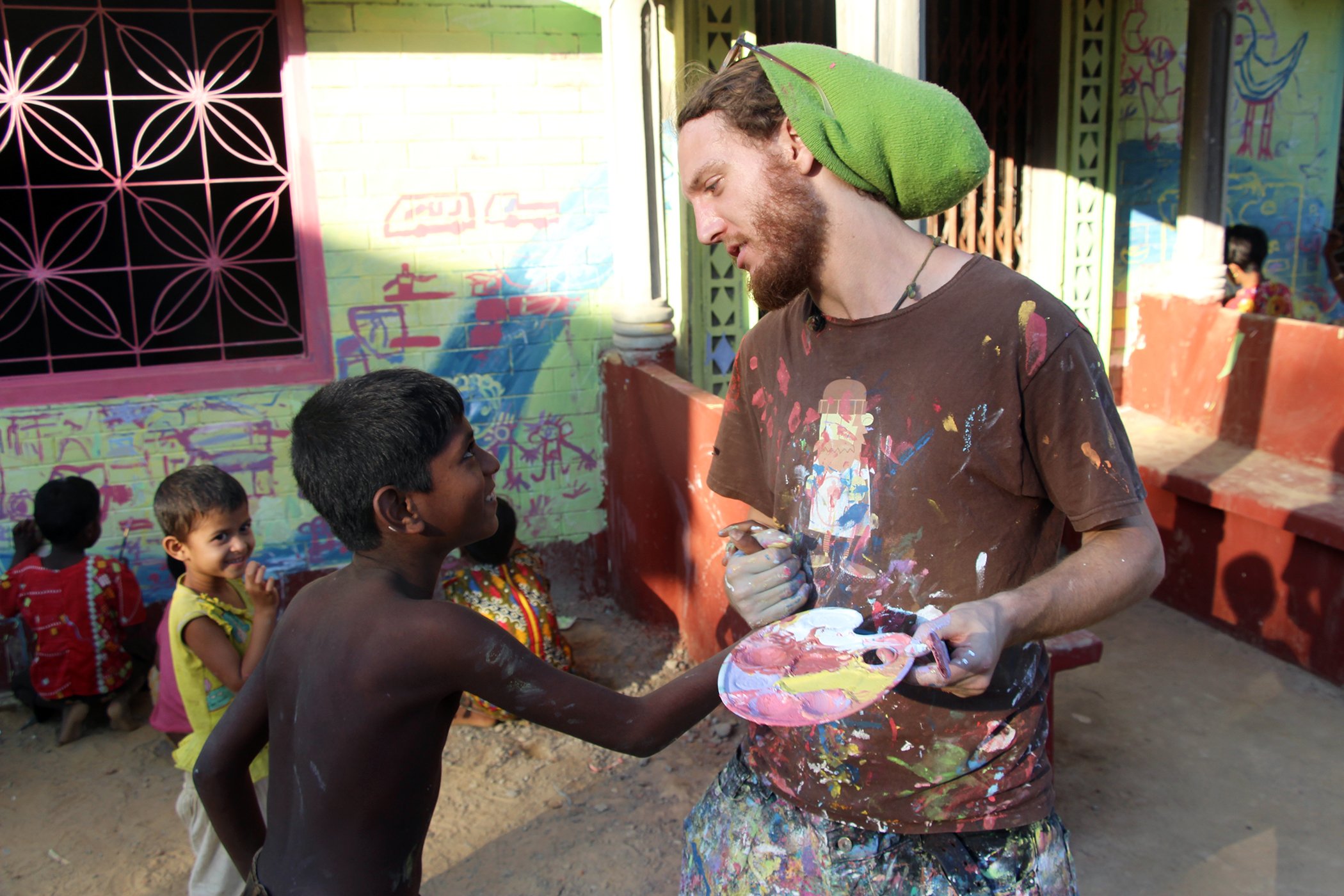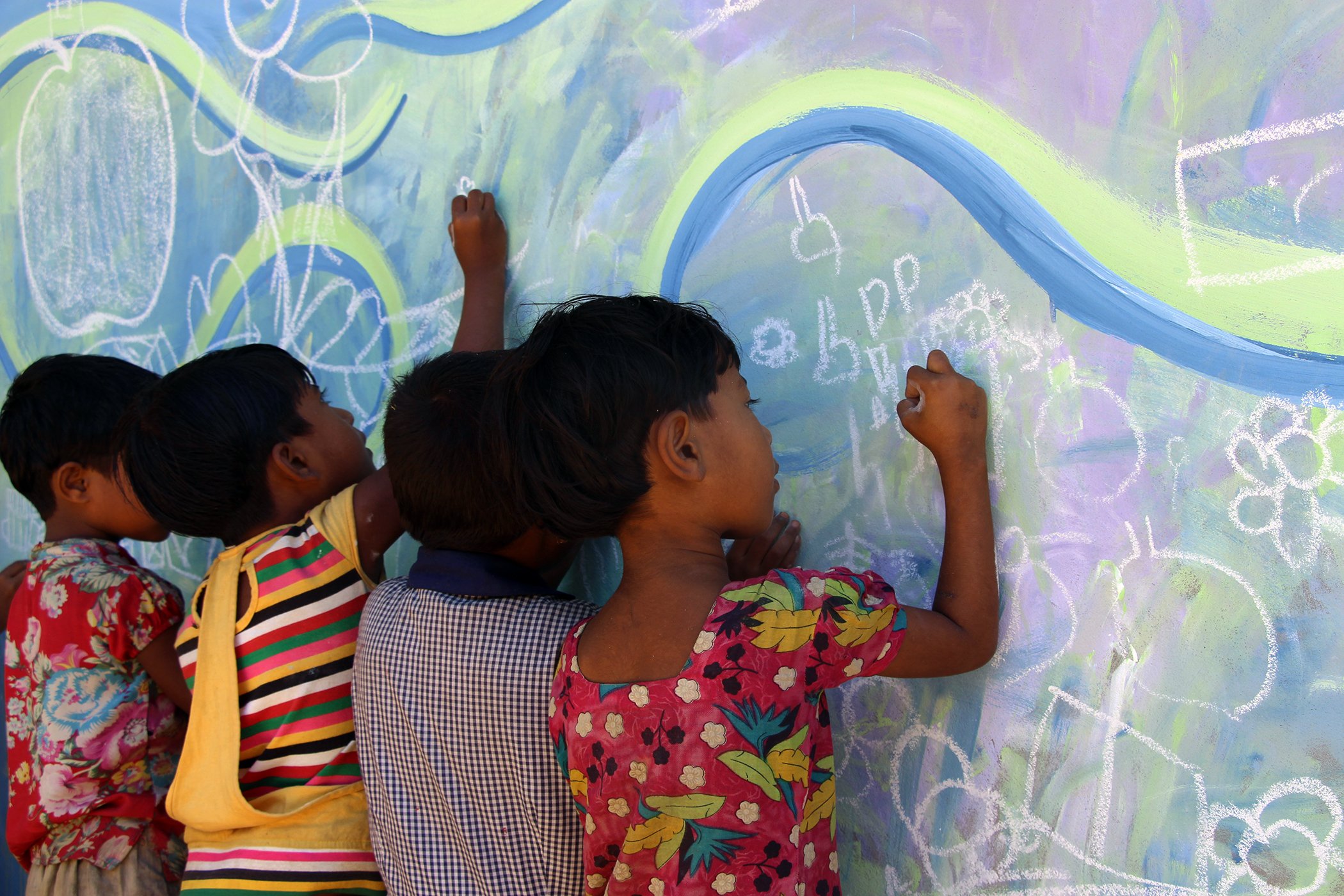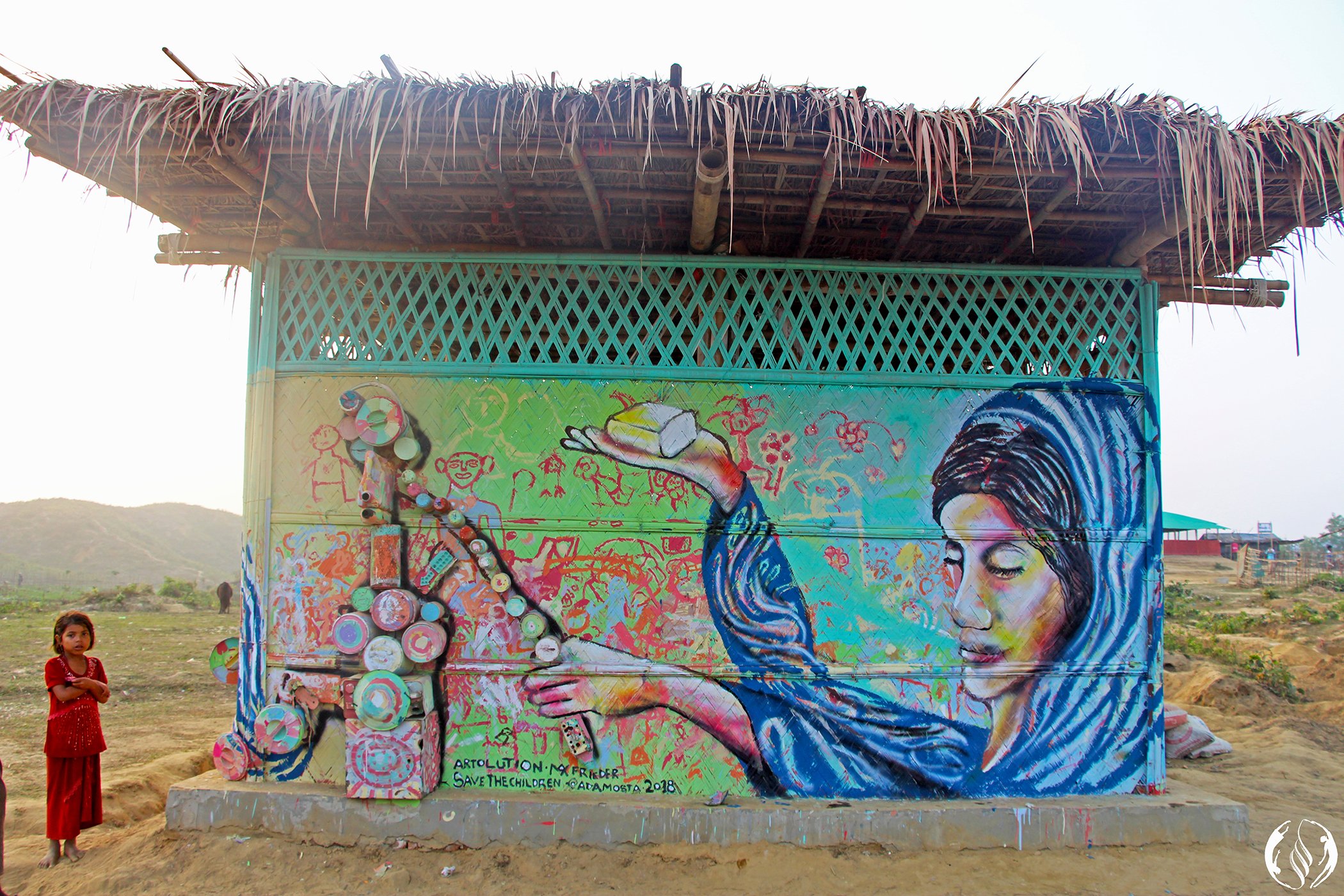Royima* picks up a green pen and draws a flower. It has a healthy stalk, budding leaves, and long filaments looping out from the petals. Then she does the same with a red pen. On the paper in front of her, a small, colorful garden begins to emerge.
She sits cross-legged on the floor of a small, improvised community center run by the NGO Save the Children in the Balukhali refugee camp in Bangladesh. The space is filled with girls and boys drawing similar pictures: flowers, gardens, trees, grass, rivers, small homes, families.
As they draw, the repetitive sounds of a small drum ring out, mingling in with the light chatter of the kids, all of them refugees from one of the world’s most violent conflicts, in neighboring Myanmar.
The group of children will later take the images they draw here, and the lessons learned through translated group discussions, and turn them into a community mural — the first piece of public art in the world’s largest refugee camp — with the help of 28-year-old artist and educator Max Frieder.
Frieder is the cofounder and co-executive director of Artolution, a community-based public arts organization that works with children in some of the world’s most challenging humanitarian crises. He traveled to Balukhali Refugee Camp, home to more than 1 million Rohingya refugees, in December, 2017, and January, 2018, working with hundreds of kids to create four public murals in community spaces across the sprawling camp.
For Royima, and for hundreds of other Rohingya children, this innovative program is helping to equip kids with the basic tools of education in the hopes that their futures aren’t lost.
In the camp, art — and, as a byproduct of that, education — can be life-saving. It can provide a way for children to learn about everything from the importance of handwashing to the dangers of child marriage: things that can literally mean the difference between life and death. And in the absence of formal education, Artolution is showing the critical role art can play in some of the world’s worst humanitarian crises.
A LONG JOURNEY
Royima’s family had been in Balukhali for three months when she joined the Artolution project — and the traumatizing story of her arrival there mirrors that of many refugees in the camp.
Her family was driven from their home in Rahkine state, Myanmar, by mobs the night before Eid-ul-Adha, in late August, 2017.
As hundreds of thousands of Muslims migrated toward Mecca, in Saudi Arabia, Royima’s family embarked on a different sort of pilgrimage — to Bangladesh.
Royima, 10, is Rohingya, a member of a Muslim ethnic minority that has, for centuries, lived in the area that is now known as Rakhine in Myanmar (formerly: Burma) and that has faced discrimination from Myanmar’s Buddhist majority for decades. But shortly before this night in August, 2017, things grew increasingly more dangerous for the Rohingya.
After Rohingya insurgents, calling themselves the Rohingya Liberation Army, attacked government outposts on August 25, killing 12 soldiers, the government retaliated with a “counter-insurgency clearing operation.”
As villages upon villages, including Royima’s, were torched, the Rohingya began to flee Myanmar en masse.
Royima’s family fled to the hills above their home and made it, eventually, to the region of Cox’s Bazaar in Bangladesh, and specifically to the Balukhali refugee camp, to a part of the camp that was known simply, unremarkably, as NN.
“We don’t have any other options,” Royima told Global Citizen. “We have to stay here.”
Along with neighboring Kutupalong, Balukhali is one of two temporary homes to more than 1 million Rohingya refugees. An estimated 688,000 of those refugees fled ethnic cleansing in Myanmar between late August and the end of January, according to the United Nations Office for the Coordination of Humanitarian Affairs. Among them, nearly 60% were children.
As an adolescent girl in this crisis, in particular, the odds are stacked against Royima. In the camps, she faces an elevated risk of child marriage, sex trafficking, and domestic abuse.
Her chances of getting an education past primary school, already slim in Myanmar, where there were schools and a limited number of teachers that spoke her language, are now next to nothing. Stateless, illiterate, and already a refugee, it will be hard for her to achieve her dream.
Royima, despite all of this, wants to become an artist.
“I want to become a painter when I grow up. I want to entertain the children,” she said. “I want to give the children good opportunities to play and draw so that they don’t feel bad remembering about Myanmar.”
“When there will be peace, we will go back,” she added.
A LOST GENERATION
Prior to the mass exodus of Rohingya into the unstable life of refugee camps, kids like Royima growing up in Rakhine already faced steep challenges to getting an education.
Because the Rohingya did not have citizenship in Myanmar, they were barred from working government jobs, including becoming teachers at state-run primary or high schools, and traveling outside of the country to work or study, according to Chris Lewa, the chair of the Asia-Pacific Refugee Rights Network Working Group on Statelessness, who spoke with Global Citizen.
“This population is amazingly illiterate. It will take a whole generation to change that, and then some.” — Chris Lewa
In 2012, Rohingya students were also banned from attending Sittwe University, the only university in Rakhine.
Beginning that same year, the threat of violence meant that schools would close temporarily, forcing students to go without school for days and weeks at a time, Lewa said.
Even before the violence escalated, many parents put their boys to work instead of sending them to school — forced to do so because of high poverty levels. Often, girls were withheld education starting at age 10 due to conservative Islamic principles that predominate within the Rohingya population.
For the estimated 36% of Rohingya students who were able to attend state-run schools, teachers taught in Burmese, and not the Rohingya dialect (which has no written form), and Rohingya students were reportedly ridiculed and discriminated against by teachers.

Instead of receiving formal education in state schools, basic education was often run through international NGOs and Islamic madrassas, or centers of religious learning, Lewa said.
So-called “paddy teachers” — who were paid ‘in paddy,’ or under the table — were often the only teachers who taught in the Rohingya dialect, working at NGO-run informal schools, according to a 2012 report from the Oxford Burma Alliance, a student-run organization at Oxford University.
“Education was very neglected,” Lewa said. “Access to primary school was OK, but because the Rohingya cannot officially be teachers, many of [the Burmese teachers at Rohingya schools] were not very interested to teach there, so they often did not come to school.”
According to Oxford Burma Alliance report, three in five Rohingya have never been to school, and by those same estimates, nearly four in five Rohingya, or about 77% of the population, are illiterate today.
For adults in the Rohingya community, illiteracy is 50% higher than it is for the rest of the Myanmar population, according to a report by the Advisory Commission on Rakhine State, an initiative spearheaded by former UN Secretary General Kofi Annan.
“This population is amazingly illiterate,” Lewa said. “It will take a whole generation to change that, and then some.”
A CHILD PROTECTION CRISIS
In the camps, hundreds of thousands of Rohingya children — already un- or under-educated — now risk falling even further behind.
The International Rescue Committee has warned that half a million Rohingya children risk losing out on an education in 2018.
“Until children's rights to education in the Rohingya crisis are realized, we face the threat of a lost generation of what is already one of the world's most vulnerable populations,” Sarah Smith, IRC senior director for education, said in a statement in December.
In the camps, a rising number of Rohingya children have been subsumed into black markets for child labor — building homes, selling wares, and engaging in other forms of manual labor. Others drop out school to take care of younger siblings: it’s been estimated that 3,576 families were child-headed, according to UNHCR. High levels of child abuse by parents and teachers alike, along with the myriad traumatic experiences associated with being a refugee, have also contributed to what experts warn could become a “massive mental health crisis for children.”
For girls like Royima, child marriage and sex trafficking also pose grave concerns.
“There’s some anecdotal evidence in the case of the Rohingya that some girls are being married off soon after they move into the camps, which is worrying because it suggests that marriage is being seeing as a way of protecting girls or securing food,” Heather Hamilton, deputy executive director for Girls Not Brides, which monitors child marriage around the world, told Global Citizen.
Getting these girls into school, or some form of it, is critical to ensuring that they don’t end up in this situation, she said.
In the absence of formal schooling, which is not considered a “priority” area of humanitarian intervention by the Bangladeshi government, a network of NGOs and other international organizations have stepped up to provide resources to ensure that vulnerable children don’t slip through the cracks.
Save the Children, a nonprofit that operates in 120 countries around the world and a partner of Global Citizen, is one of these groups.
The organization currently runs 82 “child-friendly spaces,” or CFS, across the camp, which are typically areas off-limits to adults — excluding aid workers — where refugee children can play, interact, and learn, according to Lucie Eches, a child protection manager who spoke with Global Citizen.
Save the Children plans to open up 1,000 child-friendly spaces in total in Bangladesh, according to an October press release.
“[T]here is very limited access to education,” Eches told Global Citizen. “That’s why the child friendly spaces are important for children to interact and socialize and play.”
Providing these spaces is not only critical in helping children learn about the dangers of the camp, and receive psychosocial support, but also gives them a chance to pass on that information to the rest of the community.
“Education in emergencies can both sustain and save lives,” Allison Anderson, an adjunct professor at Columbia University who has spent years working in refugee camps, told Global Citizen. “By providing a safe space where children can play and learn, it’s a space to disseminate information to young people and get it out to the wider community.”
COMMUNITY ARTS

It was here in the Save the Children CFS that Frieder, from Artolution, met with groups of kids, typically in the age range of five to 17, over the course of four weeks in December and January.
He listened to their stories, and worked with four local Rohingya artists, a translator, and the kids themselves to depict those stories in community murals on the walls of the CFS. Together, they also scavenged for trash to create interactive percussive art sculptures made from found objects — cleaning up parts of the camp in the process.
Unlike in other refugee settings he’d worked, such as the Azraq camp in Jordan, Frieder was struck by the vastness of Balukhali and the population that had made it their temporary home, he told Global Citizen over a series of interviews. Hundreds of thousands of children ran wild about the camp — many unaccompanied — or worked, slinging heavy rocks and bags of rice over their shoulders.
Domestic abuse and child labor were everywhere. Men abused their wives, who abused their children, who in turn abused one another, Frieder noted.
Education was virtually nonexistent.
“Kids would not be able to read, not be able to write, would not have any ability to communicate besides verbally, and verbally it was very limited, especially for a lot of the girls,” he said. “If you have a completely illiterate population and you give children books, nothing will happen. You have to work up to the point where children can read and will want to read.”
Some children, he said, exhibited signs of severe trauma. One boy who appeared at a workshop with a deep, untreated gash on the top of his head lacked so much as the ability to pick up a paintbrush.
Frieder didn’t just teach the children how to hold the brushes, or paint on the walls. He also worked with them on breathing lessons to help them find emotional calm, and spoke to them about their stories and the trauma they had faced.
Much like Quranic teachers did in the madrassas, which formed the backbone of the kids’ experience with education, Frieder relied on call and response techniques, making exaggerated facial expressions and guttural sounds for the kids to repeat.
"You have to work up to the point where children can read and will want to read.” — Max Frieder
Together, they created works of art that not only told stories, but also included lessons about issues critical to the community’s development.
One took on the topic of clean water and proper sanitation — in it a woman holds a bar of soap and water pump made out of found objects.
Another depicted freedom of expression.
A third illustrated the phenomenon of migration, using an allegory of elephants and roosters — themes that are indigenous to the Rohingya community.
“In this severe of an emergency, you have to start to embed lessons about basic, basic ways of preserving life,” Frieder said. “I do think [education is] a lifesaving measure and I think the arts are very powerful in communicating those messages.”

THE FUTURE
Along with his team of local Rohingya artists, Frieder worked with hundreds of kids to produce four community murals in the Balukhali camp. The four artists he worked with have continued to put together similar projects in other parts of the camp, he said.
Frieder, for his part, is hopeful that the murals and found object sculptures will leave an indelible mark on both the built environment and the people that made them. And despite the bleak conditions in the camp, he sees a future for the Rohingya in girls like Royima.
“When I was [in Balukhali], I saw some of the most terrifying things you can imagine,” Frieder said. “[Some kids] will become products of that trauma, but maybe out of those 550,000 children there will be some who will be able to become leaders, who will be able to start to heal their communities and who will start to learn through education and through the arts that they can accomplish their dreams.”

But preventing Royima’s generation from becoming lost will not be easy.
Education — and especially education in emergencies — tends to be severely underfunded, even where and when it’s needed most. According to statistics from the Global Partnership for Education, funding for education in emergencies made up less than 3% of humanitarian funding in 2016.
As young girls and boys continue to be displaced around the world, organizations like Education Cannot Wait (ECW) have called on world leaders to increase funding for education in emergencies, including in Bangladesh — and you can too.
ECW, established in 2016, brings together humanitarian and development actors and distributes donor funds where they are needed most and as quickly as possible, to continue children's education in times of crisis. In late September, the fund allocated $3 million in rapid-response emergency funding to the Rohingya crisis, but, with that funding only budgeted to last until December 2017, and the crisis growing daily, it is likely that Bangladesh will need additional and greater assistance from ECW in coming months.
Global Citizen campaigns on the Global Goals for Sustainable Development, and increasing access to quality education is goal number four.
You can join us and call on world leaders to commit $350 million to Education Cannot Wait in order to help ensure that girls like Royima — and the 75 million other kids around the world whose educations have been disrupted — can see themselves in that future, too.
* Global Citizen has changed the names of children participating in Artolution's programs to protect their identity in the case of their return to Myanmar.